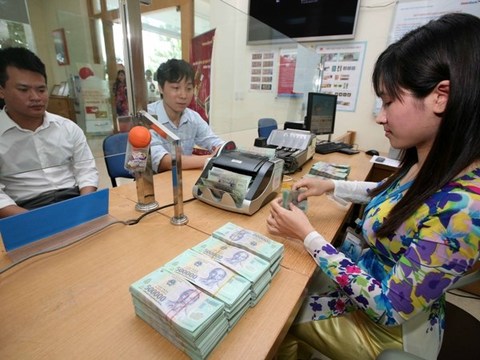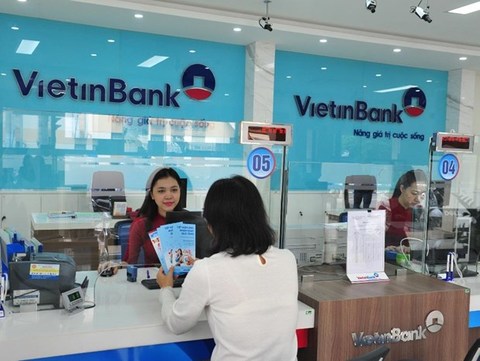Resolution upgrade sought to craft transparent debt market
Resolution upgrade sought to craft transparent debt market
Five years of banking reform are at risk of being wiped away if the bad debt ratio rises again, requiring new legislation for debt settlement with judicious changes to the present framework. Nevertheless, the detrimental influence of the pandemic is not predicted to significantly lower banks’ profit adjustment, credit growth, or net interest margin.
Changes made for bad debt settlement in 2017 need to be extended as the issues of the last 18 months have moved plans off-course. Photo: Le Toan
According to the State Bank of Vietnam (SBV), bad debt and the identification of prospective debt as bad debt have climbed dramatically since the beginning of the year, bringing the entire system back to the level seen in 2016 and 2017.
Le Trung Kien, representative of the Inspection and Supervision Agency at the SBV said that the introduction of Resolution No.42/2017/QH14 on piloting the bad debt settlement of credit institutions in 2017 has brought numerous outcomes in banks’ restructuring plans, linked with bad debt settlement across 2016-2020.
Non-performing loans (NPL) fell from 1.99 per cent at the end of 2017 to 1.91 per cent in 2018, and then to 1.63 per cent in 2019. However, by 2020 the figure had risen to 1.69 per cent, and by the end of September, it rose to 1.9 per cent. In short, Kien said, the current figure is as high as before Resolution 42 was introduced. “Needless to say, we can feel the brunt of how devastating the pandemic’s impact on credit institutions has been,” he added.
In Q3, many localities had to enforce protracted social isolation, thus manufacturing and commercial operations and supply networks were disrupted, which in turn impeded banks’ performance.
Nguyen Quoc Hung, general secretary at the Vietnam Banks Association (VBA), stated companies continue to encounter several challenges in both combating the disease and maintaining their production. On average, 10,000 companies had to halt or close their businesses, including banks’ clients. Consequently, this could put the banking industry in jeopardy, and NPLs may rise in the near future.
On the other hand, credit institutions are seeking to extend the period of Resolution 42 on debt settlement and the necessity to adopt this regulation because existing loans have not yet been addressed and new NPLs are under increasing pressure.
Tran Phuong, chairman of the Policy Committee at the VBA and a representative of BIDV, also stated that Resolution 42 still has numerous issues regarding the right to seize security assets and the application of simplified processes, paperwork, and payment priority, among others.
Phuong also proposed that state agencies expedite the process of removing obstacles related to the mechanism while also working closely with credit institutions to solve debt settlement operations, enhance online activities, and avoid stagnation when receiving dossiers for settlement, as well as promote a transparent debt market.
Vietnam Asset Management Company (VAMC) in mid-October officially established the country’s first debt exchange platform to pave the groundwork for larger-scale legal trading of distressed assets.
Katia D’Hulster, lead financial specialist, and Ruth Neyens, senior consultant at the World Bank, emphasised that a fully functioning NPL market together with an electronic debt trading platform is required to facilitate the disposition of the large volume of distressed assets held by the VAMC and the banks.
“The development of an NPL market is complex, multifaceted, and goes far beyond just creating a legal and regulatory framework to support NPL transactions,” they wrote. “Successful NPL market development requires a more coordinated and consultative approach amongst numerous stakeholders within the government, the broader financial community and, other private sector participants, both domestic and foreign. This approach provides a unique opportunity to build a market that considers the needs of all its participants.”
Many banks have ramped up their presence in other non-credit services to improve their net interest margin owing to higher interest rates than traditional lending.
Banks are vying with each other on mobilising current account saving accounts (CASA) to assist lower capital expenses, which will be a prevalent trend.
“Furthermore, the sustained decline in deposit interest rates will assist banks in lowering capital expenses in 2021 and 2022. Some banks with a high CASA ratio (Techcombank, MB, Vietcombank, and MSB) are expected to gain an upper hand. A ratio greater than 30 per cent enables these banks to have low capital expenses, thus enhancing their efficiency,” noted BIDV Securities Company (BSC).
Besides this, lending growth of 13 per cent this year has been aided by banks’ easing of credit objectives in Q4. Many banks were given extra credit objectives if the credit cap was attained within the first nine months of the year.
Accordingly, TPBank has been allocated the largest credit growth for the development of 23.4 per cent for the entire year of 2021.
Following that, Techcombank, MSB, and MB grew by 22.1, 22, and 21 per cent, respectively, illustrating a more pliant quota to pursue their expansion objectives.
BSC also updated its forecast for the entire banking industry’s revenues and profits in 2021 to $17.7 billion, up 16.7 per cent on-year and $7.1 billion, up 24.2 per cent, respectively. This growth rate remains unprecedented in comparison to 2020.
BSC further stated that the reduced profit forecasts are mostly attributable to the provisioning for debt rescheduling circular in H2/2021, as well as the anticipated modest drop in asset quality owing to the pandemic.























